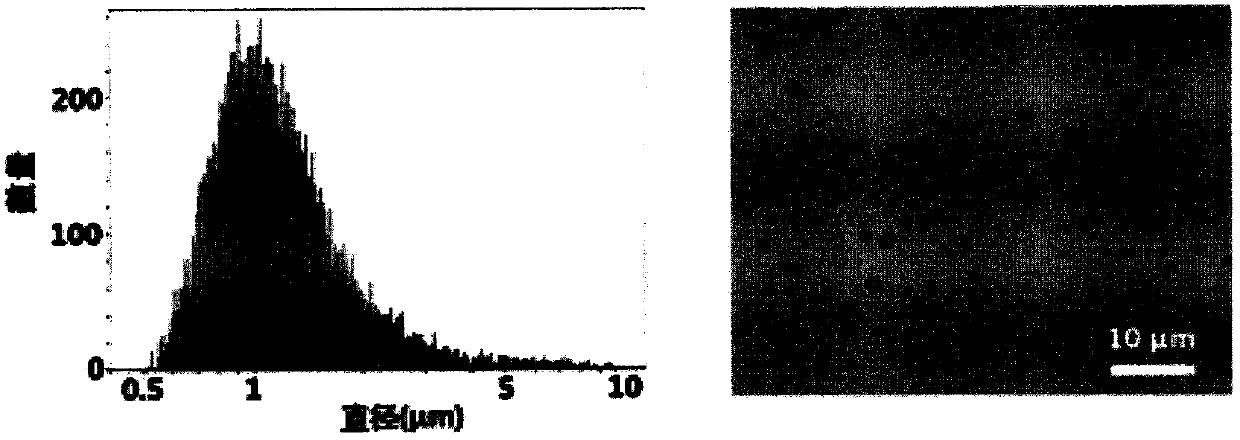Preparation of medicine-carrying nano particles transmitting blood brain barrier and application of nano particles in cooperation with focused ultrasonic targeted micro-bubble damage technology
A blood-brain barrier and drug-loaded nanotechnology, applied in the field of biomedicine, can solve the problems of curcumin hindrance and poor stability
- Summary
- Abstract
- Description
- Claims
- Application Information
AI Technical Summary
Problems solved by technology
Method used
Image
Examples
Embodiment 1
[0022] According to curcumin and N, N-di-hexadecyl-Nα-6-(3-triethoxysilyl) propyl dimethylaminocaproyl-L-alaninamide in a molar ratio of 1:15 Organic / inorganic complex lipids in chloroform (CHCl 3 ) and mix well. Using the film hydration method, the above system was evaporating in a water bath at 55° C. for 15-30 minutes until the solvent was completely evaporated to form a film. Add 5% polysorbate 80 deionized aqueous solution, hydrate the film in a 55°C water bath for 15-30 minutes, and use an ultrasonic pulverizer at 20% strength for 10 minutes to fully disperse it. The resulting system was left overnight at 4°C until it self-assembled to form curcumin nanoparticles, and centrifuged at 6000 rpm to remove unencapsulated free curcumin. The nanoparticle structure of the system is uniform and stable, and the particle diameter is about 110 nanometers observed by transmission electron microscope and atomic force microscope. Specific as figure 2 shown.
Embodiment 2
[0024] Mix distearoylphosphatidylcholine (DSPC) and distearoylphosphatidylethanolamine-polyethylene glycol 2000 (DSPE-PEG2000) in a molar ratio of 1:9, and then use the ethanol injection method to sonicate in a water bath at 50°C. Under certain conditions, the above mixture was injected into 0.8 ml of water; the solution obtained above was placed in a dialysis bag with a molecular weight cut-off of 8000-14000 Da, and dialyzed for 2-4 hours, and after taking it out, 100 microliters of glycerin and propylene glycol were added and mixed evenly. Put the mixed solution into a 3.5ml vial, fill it with a sufficient amount of perfluoropropane gas, and vibrate with an oscillator for 30 seconds. After separation and purification, microbubbles for targeted destruction by focused ultrasound are obtained. The size of the microbubbles is between 0.5- 2 microns, showing a relatively narrow distribution, and the size of the surface microbubbles is relatively uniform. Specific as image 3 sho...
Embodiment 3
[0026] In order to evaluate the effect of polysorbate 80-modified siliceous nanoparticles and microbubbles in Example 1-2 on opening the blood-brain barrier in the targeted destruction of focused ultrasound, the mice were fixed in a stereotaxic apparatus, and polysorbate was injected intravenously. Sorbitol 80-modified siliceous nanoparticles and microbubbles at a concentration of 2 × 10 5 One per gram of body weight, and adopt the acoustic parameter conditions of a center frequency of 1.28MHz and an ultrasonic sound pressure of 0.6MPa, and act for 1 minute. Then at 0.1, 6, 12 and 24 hours, the mice were perfused with normal saline and fixed with 4% paraformaldehyde, the brain tissue was separated, and the content of curcumin in the three-dimensional brain tissue was observed by fluorescence imaging using the Caliper Spectrum IVIS imaging system and quantitative. Specific results such as Figure 4As shown, group 1 is the normal saline control group, group 2 is the curcumin c...
PUM
 Login to View More
Login to View More Abstract
Description
Claims
Application Information
 Login to View More
Login to View More - R&D
- Intellectual Property
- Life Sciences
- Materials
- Tech Scout
- Unparalleled Data Quality
- Higher Quality Content
- 60% Fewer Hallucinations
Browse by: Latest US Patents, China's latest patents, Technical Efficacy Thesaurus, Application Domain, Technology Topic, Popular Technical Reports.
© 2025 PatSnap. All rights reserved.Legal|Privacy policy|Modern Slavery Act Transparency Statement|Sitemap|About US| Contact US: help@patsnap.com



